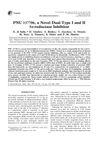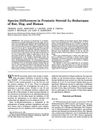TLDR Finasteride's effect on hair loss and prostate enlargement depends on its binding to an enzyme, with maximum impact at 0.2 mg dose.
This study investigated the pharmacokinetics and pharmacodynamics of finasteride, a drug used to treat hair loss and prostate enlargement. The study found that the drug's binding to steroid 5α-reductase, an enzyme involved in the production of dihydrotestosterone (DHT), is a determinant of its nonlinear pharmacokinetics. The study also found that the drug's inhibition of 5αR1 is negligible in the dose range up to 1 mg, and that the serum DHT-reducing effect of finasteride reaches its maximum at a dose of 0.2 mg in the case of repeated administration. The study concludes that the time-dependent increase in AUC observed during repeated oral administrations of finasteride may be explained by the saturation of finasteride binding to 5αR2.
 60 citations
,
December 1998 in “Clinical Pharmacology & Therapeutics”
60 citations
,
December 1998 in “Clinical Pharmacology & Therapeutics” Both drugs lower DHT levels, with GI198745 being more effective.
 42 citations
,
February 1998 in “The Journal of Steroid Biochemistry and Molecular Biology”
42 citations
,
February 1998 in “The Journal of Steroid Biochemistry and Molecular Biology” PNU 157706 is a more effective treatment than finasteride for conditions caused by DHT, like enlarged prostate and hair loss.
 136 citations
,
March 1996 in “Journal of the American Chemical Society”
136 citations
,
March 1996 in “Journal of the American Chemical Society” Finasteride effectively blocks enzyme causing male pattern baldness.
 93 citations
,
January 1996 in “Clinical Pharmacokinectics”
93 citations
,
January 1996 in “Clinical Pharmacokinectics” Finasteride helps regrow hair and shrink prostate by reducing DHT, with some sexual side effects.
 8 citations
,
January 1991 in “European Urology”
8 citations
,
January 1991 in “European Urology” Finasteride lowers DHT levels and raises testosterone in a dose-dependent way.
 193 citations
,
August 1985 in “Endocrinology”
193 citations
,
August 1985 in “Endocrinology” Different animals have unique versions of the enzyme that changes testosterone into another hormone, which is important for creating effective treatments for prostate and hair loss conditions.
 16 citations
,
January 2010 in “Drug Metabolism and Pharmacokinetics”
16 citations
,
January 2010 in “Drug Metabolism and Pharmacokinetics” Finasteride's effect on hair loss and prostate enlargement depends on its binding to an enzyme, with maximum impact at 0.2 mg dose.
 30 citations
,
August 1992 in “The Journal of Clinical Endocrinology and Metabolism”
30 citations
,
August 1992 in “The Journal of Clinical Endocrinology and Metabolism” Finasteride doesn't affect hormone levels in normal men.









